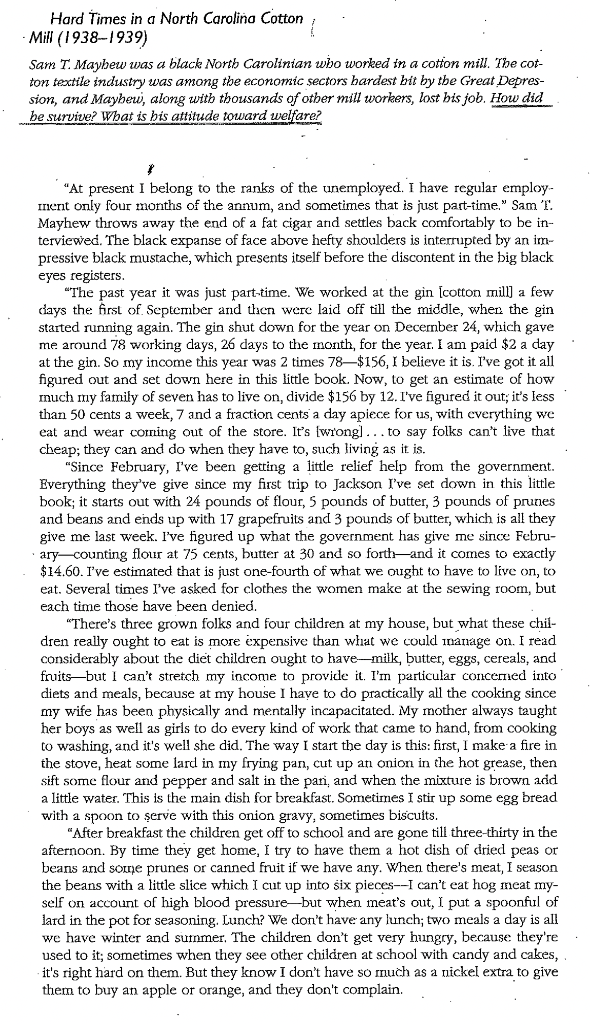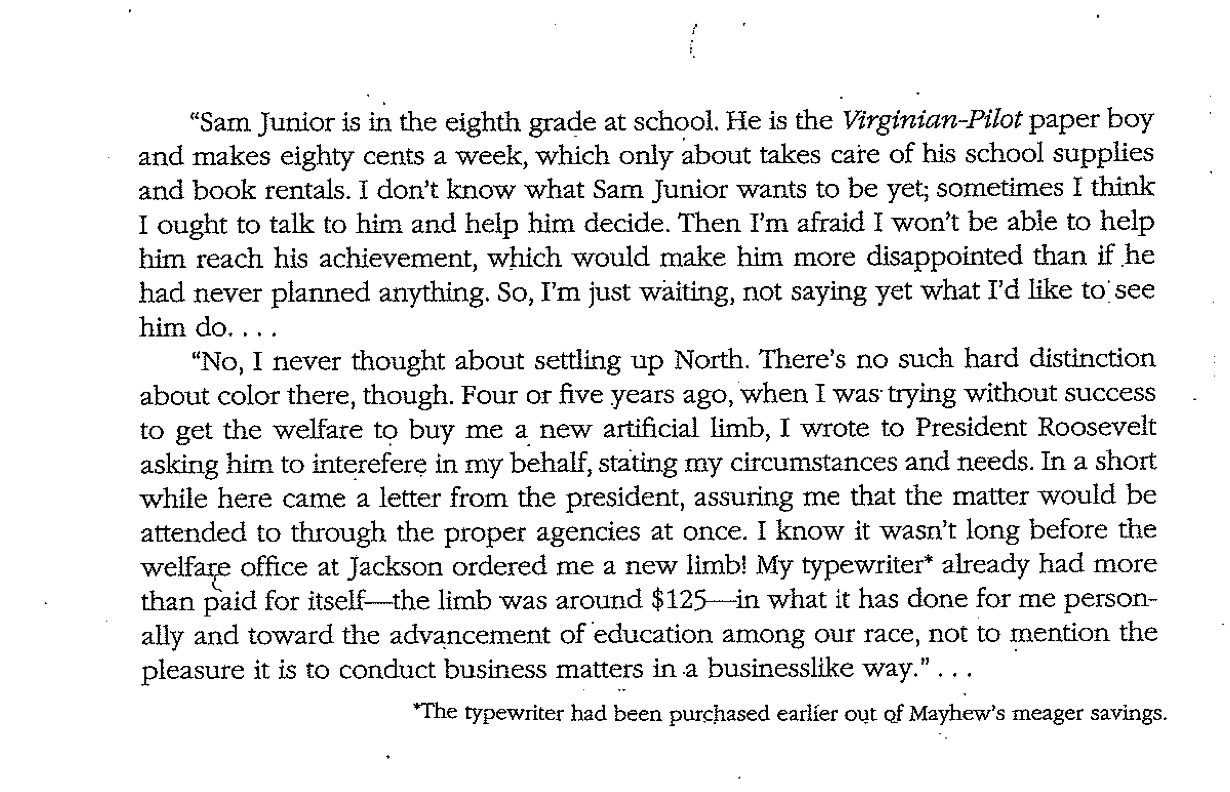Answered step by step
Verified Expert Solution
Question
1 Approved Answer
how did he survive? what is his attitude towardswelfare? Hard Times in a North Carolina Cotton Mill (1938-1939) Sam T. Mayhew was a black North
how did he survive? what is his attitude towardswelfare?

Hard Times in a North Carolina Cotton Mill (1938-1939) Sam T. Mayhew was a black North Carolinian who worked in a cotton mill. The cot- ton textile industry was among the economic sectors hardest bit by the Great Depres- sion, and Mayhew, along with thousands of other mill workers, lost his job. How did be survive? What is his attitude toward welfare? 1 "At present I belong to the ranks of the unemployed. I have regular employ- ment only four months of the annum, and sometimes that is just part-time." Sam T. Mayhew throws away the end of a fat cigar and settles back comfortably to be in- terviewed. The black expanse of face above hefty shoulders is interrupted by an im- pressive black mustache, which presents itself before the discontent in the big black eyes registers. "The past year it was just part-time. We worked at the gin [cotton mill] a few days the first of September and then were laid off till the middle, when the gin started running again. The gin shut down for the year on December 24, which gave me around 78 working days, 26 days to the month, for the year. I am paid $2 a day at the gin. So my income this year was 2 times 78-$156, I believe it is. I've got it all figured out and set down here in this little book. Now, to get an estimate of how much my family of seven has to live on, divide $156 by 12. I've figured it out; it's less than 50 cents a week, 7 and a fraction cents a day apiece for us, with everything we eat and wear coming out of the store. It's wrong)... to say folks can't live that cheap; they can and do when they have to, such living as it is. "Since February, I've been getting a little relief help from the government. Everything they've give since my first trip to Jackson I've set down in this little book; it starts out with 24 pounds of flour, 5 pounds of butter, 3 pounds of prunes and beans and ends up with 17 grapefruits and 3 pounds of butter, which is all they give me last week. I've figured up what the government has give me since Febru- ary-counting flour at 75 cents, butter at 30 and so forth-and it comes to exactly $14.60. I've estimated that is just one-fourth of what we ought to have to live on, to eat. Several times I've asked for clothes the women make at the sewing room, but each time those have been denied. "There's three grown folks and four children at my house, but what these chil- dren really ought to eat is more expensive than what we could manage on. I read considerably about the diet children ought to have-milk, butter, eggs, cereals, and fruits but I can't stretch my income to provide it. I'm particular concerned into diets and meals, because at my house I have to do practically all the cooking since my wife has been physically and mentally incapacitated. My mother always taught her boys as well as girls to do every kind of work that came to hand, from cooking to washing, and it's well she did. The way I start the day is this: first, I make a fire in the stove, heat some lard in my frying pan, cut up an onion in the hot grease, then sift some flour and pepper and salt in the pari, and when the mixture is brown add a little water. This is the main dish for breakfast. Sometimes I stir up some egg bread with a spoon to serve with this onion gravy, sometimes biscuits. "After breakfast the children get off to school and are gone till three-thirty in the afternoon. By time they get home, I try to have them a hot dish of dried peas or beans and some prunes or canned fruit if we have any. When there's meat, I season the beans with a little slice which I cut up into six pieces--I can't eat hog meat my- self on account of high blood pressure-but when meat's out, I put a spoonful of lard in the pot for seasoning. Lunch? We don't have any lunch; two meals a day is all we have winter and summer. The children don't get very hungry, because they're used to it; sometimes when they see other children at school with candy and cakes, it's right hard on them. But they know I don't have so much as a nickel extra to give them to buy an apple or orange, and they don't complain.
Step by Step Solution
★★★★★
3.43 Rating (153 Votes )
There are 3 Steps involved in it
Step: 1
Survival Strategies Sam T Mayhews survival strategies involve a combination of parttime employment government relief assistance and careful budgeting ...
Get Instant Access to Expert-Tailored Solutions
See step-by-step solutions with expert insights and AI powered tools for academic success
Step: 2

Step: 3

Ace Your Homework with AI
Get the answers you need in no time with our AI-driven, step-by-step assistance
Get Started


